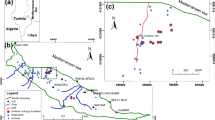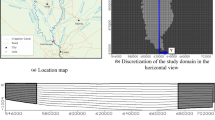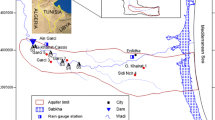Abstract
Groundwater depletion and seawater intrusion constitute major challenges along coastal aquifers in arid areas. This paper assesses the role of groundwater recharge dams constructed to replenish aquifers and fight seawater intrusion with reference to AlKhod dam, Oman, sited 7 km from the coast on a gravely unconfined aquifer. Water table rise in piezometers located downstream from the dam shows regular patterns correlating with magnitude of wadi flow, whereas upstream piezometers show irregular patterns. Controlled release of water captured by the dam optimizes water percolation and enhances artificial recharge which was estimated in the wet years 1997, 2003 and 2005 as 15, 22 and 27 Mm3, respectively, using water table fluctuation method. Recharge contributed 40–60 % of the total annual abstraction. Groundwater salinity increased in the 1980s and 1990s and the saline/freshwater interface advanced inland, but has receded partially after 1997 (highest rainfall) and completely after 2005 indicated by reduction in electrical conductivity and thickening of freshwater lens. The recession is attributed to the dam’s induced recharge and reduction of pumping in 2004 following the commissioning of Barka desalination plant. Integrating artificial recharge with groundwater resources management is therefore an effective measure to replenish aquifers in arid areas and mitigate seawater intrusion along the coasts.









Similar content being viewed by others
Explore related subjects
Discover the latest articles and news from researchers in related subjects, suggested using machine learning.References
Abdalla OAE, Ali M, Al-Higgi K, Al-Zidi H, El-Hussain I, Al-Hinai S (2010a) Rate of seawater intrusion estimated by geophysical methods in arid area of Al Khabourah, Oman. Hydrogeol J 18:1437–1445. doi:10.1007/s10040-010-0606-0
Abdalla OAE, Suliman FO, Al-Ajmi H, Al-Hosni T, Rollinson H (2010b) Cyanide from gold mining and its effect on groundwater in arid areas Yanqul mine Oman. Environ Earth Sci 60(4):885–892. doi:10.1007/s12665-009-0225-z
Acra A, Ayoub GM (2001) Indicators of coastal groundwater quality changes induced by seawater infiltration. Intern. J. Environ. Studies 58:760–769
Al Barwani A, Helmi T (2006) Seawater Intrusion in a Coastal Aquifer: a case study for the area between Seeb and Suwaiq in the Sultanate of Oman. Agric Mar Sci 11:55–69
Al-Assa’d TA, Abdulla FA (2010) Artificial groundwater recharge to a semi-arid basin: case study of Mujib aquifer, Jordan. Environ Earth Sci 60:845–859. doi:10.1007/s12665-009-0222-2
Al-Harthy SS (1995) Al Khawd recharge dam preliminary conclusions on first years of operation. international symposium on artificial recharge of ground water—proceedings 1995, 188–197
Bajjali W (2005) Model the effect of four artificial recharge dams on the quality of groundwater using geostatistical methods in GIS environment, Oman. J Spat Hydrol Fall 5(2):1–15
De Laat PJM, Nonner JC (2012) Artificial recharge with surface water; a pilot project in wadi madoneh. Jordan Environ Earth Sci 65:1251–1263. doi:10.1007/s12665-011-1372-6
Gore KP, Pendke MS, Mal BC, Gurunadha Rao VVS, Gupta CP (1995) Assessment of impact of water conservation structures on groundwater regime in Wagarwadi Watershed, Parbhani, Maharashtra. Gondwana Geol Mag 10:63–77
Hanna SS. (1995) Field guide to the geology of Oman. Western Hajar Mountains and Musandam. The Historical Association of Oman, vol 1, Ruwi, Sultanate of Oman, p 180
Hwang S, Shin J, Park I, Lee S (2004) Assessment of seawater intrusion using geophysical well logging and electrical soundings in a coastal aquifer, Youngkwang-gun, Korea. Explor Geophys 35:99–104
Kwarteng AY, Dorvlo AS, Vijaya Kumar GT (2008) Analysis of a 27-year rainfall data (1977–2003) in the sultanate of oman. Int J Climatol. doi:10.1002/joc.1727
Limaye SD (2003) Some aspects of sustainable development of groundwater in India. IGC’S Eighth Professor Jhingran Mem. Lect., 90th Indian Science Congress, Bangalore 22 pp
Ling XM, Zhou Q, Zhang Z, Cheng Q (2012) Numerical modeling the role of rubber dams on groundwater recharge and phreatic evaporation loss in riparian zones. Environ Earth Sci 65:345–352. doi:10.1007/s12665-011-1094-9
Macumber PG (1997) Al Khawd fan groundwater investigation. Ministry of water resources, Sultanate of Oman
Ministry of Regional Municipalities and Water Resources (1996) Water resources in the sultanate of oman: an introductory guide. Ministry of regional, Sultanate of Oman
Prathapar SA (2007) Numerical Modeling of Options to Augment Artificial Recharge in Dams subjected to Sedimentation. Third International Groundwater Conference (IGC-2007) on Water, Environment and Agriculture-Present Problems and Future Challenges. Coimbatore, India
Raju JN, Reddy TVK, Munirathnam P (2006) Subsurface dams to harvest rainwater—a case study of the Swarnamukhi River Basin. South India Hydrogeol J 14:526–531. doi:10.1007/s10040-005-0438-5
Robertson AHF, Searle MP (1990) The northern Oman Tethyan continental margin: stratigraphy, structure, concepts and controversies. In: Robertson AHF, Searle MP, Ries AC (eds) The geology and tectonics of the oman region. Special publication 49, Geological society of London, pp 3–25
Salem SH, Chkir N, Zouari K, Cognard-Plancq AR, Valles V, Marc V (2012) Natural and artificial recharge investigation in the Ze′roud Basin, central tunisia: impact of Sidi Saad Dam storage. Environ Earth Sci 66:1099–1110. doi:10.1007/s12665-011-1316-1
Sharda VN, Kurothe RS, Sena DR, Pande VC, Tiwari SP (2006) Estimation of groundwater recharge from water storage structures in a semi-arid climate of India. J Hydrol 329(1–2):224–243
Acknowledgments
This project was funded by the His Majesty Fund grant #SR/SCI/ETHS/11/01. We would like to thank the Ministry of Regional Municipalities and Water Resources for providing the data.
Author information
Authors and Affiliations
Corresponding author
Rights and permissions
About this article
Cite this article
Abdalla, O.A.E., Al-Rawahi, A.S. Groundwater recharge dams in arid areas as tools for aquifer replenishment and mitigating seawater intrusion: example of AlKhod, Oman. Environ Earth Sci 69, 1951–1962 (2013). https://doi.org/10.1007/s12665-012-2028-x
Received:
Accepted:
Published:
Issue Date:
DOI: https://doi.org/10.1007/s12665-012-2028-x




